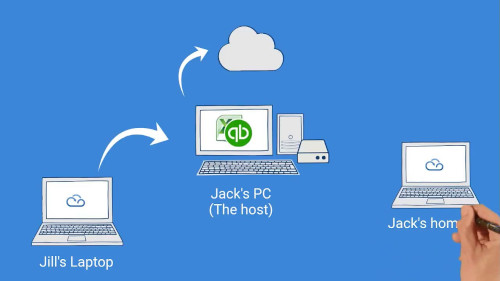Until recently, telework has been slow to adopt than people had predicted when remote working technology emerged. It’s a clear indication of the sticky work culture, lack of commitment from employers to invest in the required technology, and the hesitation from the management to implement teleworking policies.
But the coronavirus has broken the traditional working culture. Both employees and management have worked together, where possible, to implement the shift towards telecommuting. In an effort to control the pandemic, companies have come up with work-from-home policies. These policies could be the beginning of a new movement towards teleworking business models during and beyond the crisis.
According to a recent interview on the Washington Post, “People will change their habits, and some of these habits will stick. There’s a lot of things where people are just slowly shifting, and this will accelerate that.” However, these technological advancements call for more protection of company assets and information. Telecommuting has scattered business endpoints as employee devices, and IoT systems now need to be secure.
The sudden shift to telecommuting has been perhaps without the implementation of all corporate and Cybersecurity concerns. Additionally, teleworking may have an impact on occupational safety and health (OSH) of employees. Calling both the management and employees to be aware of the associated risks and develop sufficient preventive and control measures.
Late April, CISA developed a one-stop-shop telework cybersecurity guidance and resources. They have outlined proper up-to-date guidelines to navigate the telework threat landscape for government institutions and private organizations. These entail Guidance for Securing Video Conferencing, National Security Agency, and CISA Telework Best Practices, and the Cybersecurity Recommendations for Critical Infrastructure Using Video Conferencing.
So how can management implement the best practices necessary to operate a tele-workforce? MyQuickCloud reveals it all.
1. Good teleworking habits
Communication
It is very easy for messages to be ignored or overlooked, with the team spread out across multiple locations. Teleworking calls for all teams to develop operational communication cadence quickly. The rule of thumb is to over-communicate. Communication between coworkers and managers should be frequent with regular progress updates.
Organizations should work at keeping the chatter going digitally by providing instant messaging text/call tools for quick collaboration. Managers should check-in with employees or schedule one-on-one and team meetings to ensure progress towards meeting their objectives. However, don’t micro-manage or invite employees to many, immaterial teleconferences.
Time management
Set clear expectations and guidelines for work hours. Have concrete policies for office hours and time to meet project deadlines with excellence. An employment law expert Jennifer Shaw suggests, “Establish a tailored remote work agreement to clearly outline the company’s expectations, such as specifying break rules or an overtime policy specifying that overtime must be approved beforehand.”
Also, employees should ensure that they take breaks as it’s easy to work around the clock when working from home.
Plan for the kids
Working from home around kids and spouses has proven to be a challenge for many. Educate employees on managing their schedules to create ‘power-working’ sessions. Managers should also keep in mind that kids are at home, so teleconferences should take for reasonable lengths. This will boost the employee’s morale and productivity.
It’s helpful if employees to inform their families of the new expectations that come with teleworking. Help them understand when you’re working and when you’re available. Couples can alternate between occupying the kids and working. This way, one gets ample time to work uninterrupted.
2. Equipment and software
Remote access or remote desktop
It’s impossible to telework without the right tools and equipment. The only way to ensure business continuity is by making sure all staff have access to work resources. Thanks to cloud technology, employees can access company data and systems from different locations. It is time for organizations to invest in remote access and remote desktop technologies to enhance the productivity levels of their employees.
Security
We can’t overlook the need for a secure office network to protect companies from cybercrime. With remote teams, the chances for potential hacks and breaches increase as they can use their devices in unsecured public networks. Businesses should invest in Endpoint Threat Detection and Response technology to mitigate cyber threats. They should ensure the employee’s devices use a secured connection while connecting to the business network.
Solutions like MyQuickCloud Managed Cloud Server take away these worries. They have end-to-end data encryption and firewalls set up to protect your business network and data. Besides, all employees can access data using their specific authentication passwords. There are dedicated staff monitoring and auditing all system services and activities.
3. Need for speed
Well, broadband availability could be a massive limitation to managing a tele-workforce. Some households and urban areas are still digitally disconnected, and teleworking calls for access to high-speed broadband service at home. Organizations should be ready to take care of internet expenses to connect their employees to an internet service provider. With the numerous teleconferences/video calls, internet usage will go up. Employees shouldn’t bear the costs alone.
4. Policy abuse and harassment policies
Working-from-home may be perceived as a time to relax work rules and regulations by some employees. The management and human resource should come up with behavior and work policies for teleworking. An email should be sent to employees, emphasizing the importance of respecting and behaving appropriately towards each other. A harassment-free workplace is to be maintained in and out of the office.
It should be clearly stated that the remote working privilege can be revoked if an employee isn’t respectful, accountable, or meeting their work expectations. Regardless of whether work happens in a virtual or real-world, the goals and values of a company should be observed.
Conclusion
The fact is COVID-19 is a wake-up call for organizations to fully accept that the digital business era has started and speed up modernization. Yes, there may be some loopholes in the remote working business models, but they’re solvable. The advantages of investing in the required technology now far outweigh the limitations. With smart solutions like MyQuickCloud, businesses can manage to telework and meet their consistent productivity and security requirements.





